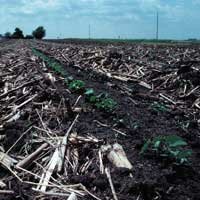
-
Diseases
- Asian Rust
- Anthracnose
- Bacterial Blight
- Bacterial Pustule
- Bean Pod Mottle Virus
- Brown Stem Rot
- Cercospora Leaf Blight
- Charcoal Rot
- Downy Mildew
- Frogeye Leaf Spot
- Green Stem Syndrome
- Iron Deficiency Chlorosis
- Phytophthora Root & Stem Rot
- Powdery Mildew
- Rhizoctonia
- Seedling Diseases
- Septoria (Brown Spot)
- SCN (Soybean Cyst Nematode)
- Soybean Mosaic Virus
- Stem Canker
- Sudden Death Syndrome
- Viruses
- White Mold
- Pests
- Biological Control
- Agronomics
- Diagnostic Tools
- About Us
- Library
Tillage
 |
|
Soybean seedlings in a ridge-till system.
Photo credit: Natural Resources Conservation Service |
Tillage, or the “physical manipulation of the soil,” is a key part of crop production. Soil is tilled to manage crop residue, lessen compaction, prepare a seedbed, kill weeds, and incorporate fertilizer.
Generally, tilling corn residue for the soybean crop year has no advantage in improving soybean yield. There may be some challenges in managing corn residue, but these can be overcome with simple modification of the planter. It is well-documented that extensive tillage has a negative effect on soil organic matter, aggregate stability, and soil structure. It often causes soil compaction and soil erosion. Therefore, reduced or conservation tillage systems are highly recommended by agronomists.
Tillage definitions
Conservation tillage is defined to be any tillage and planting system that leaves 30 percent or more of the soil surface with crop residue, after planting.
- No-till or strip-till is a tillage and planting system in which the soil is left undisturbed from harvest to planting except for strips up to one-third of the row width (strips may involve only residue disturbance or may include soil disturbance). Cultivation may be used for emergency weed control. Also called direct-seeding.
- Ridge-till is a system in which the soil is left undisturbed from harvest to planting except for strips up to one-third of the row width. Planting is completed on the ridge and usually involves the removal of the top of the ridge. Residue is left on the surface between ridges. Ridges are rebuilt during row cultivation.
- Mulch-till is full-width tillage involving one or more tillage trips which disturbs all of the soil surface and is done prior to and/or during planting. This system differs from reduced or conventional tillage only because it leaves more than 30 percent residue cover after planting.
Reduced tillage is defined as a tillage system which leaves 15 to 30 percent residue cover after planting.
Conventional tillage or intensive tillage is a full-width tillage system which disturbs all of the soil surface and leaves less than 15 percent residue cover after planting. It generally involves plowing or intensive and numerous tillage trips.
Resources
Tillage Type Definitions - Conservation Technology Information Center, Purdue University
Factors to Consider when Making Tillage Decisions - University of Minnesota
Tillage Considerations for Disease Management - Iowa State University
Can Residue Be Managed Successfully with No-Till? - Iowa State University
Soil Management and Conservation Practices website - Iowa State University
Is Fall Tillage Following Soybean Harvest Necessary? - University of Wisconsin
Fall Strip Tillage Systems: An Introduction - Ohio State University Fact Sheet AEX-507-00
Choosing the Right Tillage System for Row Crop Production - University of Nebraska

